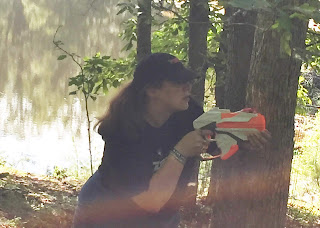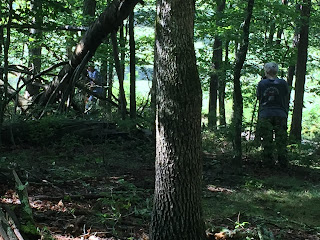I got there and met up with some of the early arrivals
who were setting up “home base” under a tent with some chairs, bottles of water
and about three good sized storage containers filled with a mix of very
different looking phasers.
These were all home-use laser taggers that are compatible
with each other. They would be considered “toy tag” within the industry.
However, I learned that there’s actually a bit of a tie back to early laser tag
in that these were basically all Lazer Tag (history lesson Cody: Lazer Tag spelled
with a Z was the Worlds of Wonder brand that competed with the LJN toy home version
of Photon. Those two brands combined were the number one toy category during
the Christmas season of 1986 (cite: my interview with George Carter III).
So what is the connection? I’ll let Erik field this one
with some history about Shoot the Moon and Laser Tag Team Ops developers David
Small and Paul Rago from the Laser Tag Team Ops page on the Laser Tag Museum
website.
OK, so that’s where we started and Scott gave me a lesson
in the various phaser choices (they call them taggers) and the differences
between them. For instance, the first one he showed me was a Tag Master Blaster
with auto reload…
…a bottom button for the shield…
…and a realistic distance (by his estimation) of about a
600-800 foot range. And as he pointed out, the larger lens = a larger beam.
There were a few smaller options as well.
And one looked particularly familiar to me.
This looks a lot like something I had purchased a couple
of years ago and only used a couple of times with an app on my old iPhone 4S. I
really knew very little of what it could do (besides shooting at imaginary
aliens on the phone screen that I could chase around my living room…I digress),
but this weekend I learned a lot more about it. This would fall into the realm
of LTAR (Laser Tag Augmented Reality). It has a shield activated by the front
of the circle opposite the trigger and a manual reload. I must admit I was
clueless about it even though I actually own one. So this was a great chance to
see what it was truly designed to do. With a dome sensor on the top of the
barrel to aim for these phasers all are self contained taggers that worked well
together in combination.
Now, with the right set up using a computer you could
potentially run hosted games where you could track more information about the total
game and individual results on a screen, but we were set up in a wooded area and
the games for this event were non-hosted. It was explained that for the games
today objectives and meeting a goal were more about working with your team than
about individual score. The first game we played was Alamo with one team going
out into the field to defend a little wooded “Alamo”.
My team hung back until they were positioned and we got
some strategy suggestions while looking at the map of the area that spanned
about 1100x700 feet in the woods along the pond.
Basically the opposing team would stay around the Alamo
to defend while the offense would come up and attack from all directions.
For me the biggest challenge was the terrain. I showed up
in sport tag attire and the rest of the players were in camo looking ready for
battle. So I just stayed close to players who knew the field and just did my
best to aim my phaser and not trip on a root and fall down. I was 99%
successful. :)
The next game we played was Zombies. Ah, something
familiar! Or so I thought…and I was wrong.
The game was described very similarly to how Zombies is
played with traditional tag (only with a better back story that I’m told is
akin to Resident Evil. I’ll take their word for that.), but in actuality it
played VERY differently. In this game one person was assigned to be the “zombie”.
He could take ten hits and then reload for as many as ten
more. The rest of us “humans” could take ten hits before becoming a zombie,
which would be identified by putting a red velcro band around your arm.
To my knowledge none of us had to put the red arm band
on. It was NOT because we were so exceptionally great at this game. It was
because nobody actually found the zombie player for about half an hour! So this
game ended up being more about tracking down the one player in what felt like a
really big field of trees. Again I stayed close to players who knew the terrain
because I did not want this to end with me getting lost in the woods.
But once the zombie was found the game ended with a few
good shots being placed rather quickly and no humans turning zombie in the
process.
Then we played a game called The Cube. It had a special
prop.
This cube was assembled from PVC pipe and had a special
phaser suspended by bungee cords in the center. On the heels of the longer
Zombie game this was intended to be a quick ten minute adventure for two teams where
the goal was to tag players and get as close to the cube as possible for extra
points while you are “up”, but if you are neutralized the cube can shoot at you
very quickly (from the dome) and tag you repeatedly.
Each player could take 99 hits before being deactivated,
but that sure doesn’t feel like as many as it sounds like when the cube is
after you and opposing team players can pick up the cube and chase you with it!
This game was a little confusing, but we all did our best. I think the cube won…lol.
After a few games the group returned to the home base.
Here I learned a little bit more about the modifications
that could be made to some of the tag equipment with a bit of ingenuity. Scott
showed me a large phaser that was basically modded from the smaller phaser
design he showed me side by side.
This world of tag modifying is both interesting and
baffling to me as it feels so far removed from what I know and yet the
principles behind all forms of laser tag are so similar. I came here wanting a
unique and different laser tag experience and that is exactly what I got. It
was such a cool opportunity to learn about and play tag using different
equipment than I ever have before. I want to thank the Laser Tag Club at
Virginia Tech for hosting this event and I hope I have an opportunity to
participate again!
Comments or Questions?
Contact: tivia@tiviachickloveslasertag.com






















No comments:
Post a Comment